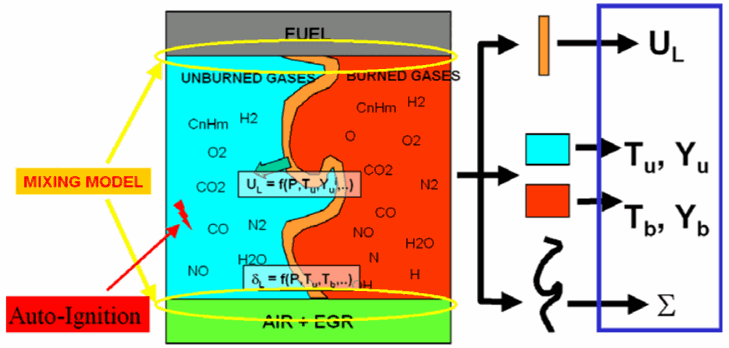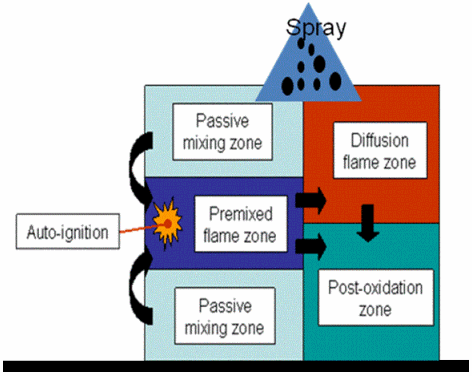Internal Combustion Engines
In an internal combustion engine (ICE), for example a gasoline engine, the process of combustion takes place in a cylinder (or cylinders) within the engine. The working fluid is a fuel and oxidizer mixture (usually air), which reacts to form combustion products.
Currently, there are three combustion models
that you can use to simulate combustion within an internal combustion engine:
- ECFM-3Z or ECFM-CLEH: Only available when using Simcenter STAR-CCM+ In-cylinder. Provides an efficient method for simulating internal combustion engines without the expense of modeling complex chemistry.
- Complex Chemistry: Provides a more accurate, yet more expensive, method for simulating internal combustion engines compared to the ECFM models.
| Model | Ignition | Soot | NOx / Emissions | |
|---|---|---|---|---|
| ECFM-3Z
ECFM-CLEH |
|
The Soot Two-Equation model is
built-in. The Soot Moments model is also available. |
The NOx Thermal model is built-in
for ECFM-3Z and an optional model for ECFM-CLEH. The following NOx
emission models are also available: |
|
| Complex Chemistry |
|
The following soot models are available: | The following NOx emission models are available: | |
ECFM-3Z
The Extended Coherent Flame Model Three Zone
(ECFM-3Z) model is capable of simulating the complex mechanisms of turbulent mixing,
flame propagation, diffusion combustion, and pollutant emission that characterize
modern internal combustion engines. It can also be used for in-cylinder analysis in
a multi-injection environment and for multi-cycle simulations. There are four major
components to the mathematical structure of the ECFM-3Z model:
- Mixing model
- Flame propagation model
- Post-flame and emissions model
- Spark ignition model and auto-ingition/knock models

In the diagram above, EGR denotes exhaust gas recirculation, denotes the flame surface, is laminar flame speed (denoted elsewhere as ), and are the unburnt and burnt temperatures respectively, and and are the unburnt and burnt mass fractions.
ECFM-CLEH
ECFM-CLEH is a combustion model in which burning rates are limited by a thermodynamic
equilibrium given by complex chemistry. In this model, the computational cells are
split into four zones: unmixed, premixed, diffusion, and post-oxidation. This leads
to the need for distinguishing four combustion modes: auto-ignition, flame
propagation, diffusion combustion, and post-oxidation. The fuel in these zones is
then distinguished as:
- Fuel Premixed
- Fuel Unmixed
- Fuel Diffusion
- Fuel Post-oxidation

Complex Chemistry
Ignition Models
- Spark Ignition
- Currently, the following spark ignition
models are available with the ECFM models:
- FI Spark Ignition
- ISSIM Spark Ignition
- Subgrid Spark Ignition
- Auto-Ignition
- Currently, the following auto-ignition
models are available with the ECFM models:
- ECFM Standard Auto-Ignition
- ECFM TKI Auto-Ignition